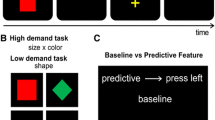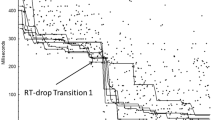Abstract
Implicit learning, i.e. knowledge acquisition in incidental learning situations, is a fundamental feature of the human mind. The extraction of (and subsequent adaptation to) regular patterns in the environment facilitates everyday actions. The cognitive and neural processes accompanying the transition from subconscious (implicit) to verbally reportable (explicit) knowledge about task contingencies are of high interest to the cognitive neurosciences, since they indicate a process that generates awareness for learned associations. Previous studies indicated an important role of high-frequency coupling (gamma-band) for the process that initiates the emergence of awareness for an implicitly learned task-underlying structure. It is unclear, however, whether this EEG coupling is indicative of a general, task-independent process accompanying the shift between implicit and explicit knowledge. To test the general role of this synchrony effect, we investigated EEG gamma-band coherence in the time period where this transition takes place using a serial reaction time paradigm. As expected, we find increased coupling in the gamma-band EEG between right prefrontal and occipital electrode sites just before the behavioural manifestation of emerging explicit sequence representation. These results support both the notion of general involvement of widespread cortical associative couplings in the generation of conscious knowledge and the necessity to study emerging consciously available memory representations using fine-grained properties of behavioural data.







Similar content being viewed by others
Notes
The MATLAB functions for these analyses are available from the corresponding author upon request.
Be aware that this preprocessing step is not absolutely necessary prior to blind source separation using ICA, yet it is highly recommended (Delorme et al. 2007), because it prevents spurious stretches of high-power artifact activity (like a subject scratching its head, touching a cable, or yawning excessively) to limit the component subspace for event-related and stereotyped activity. There are also other methods of blind and semi-blind source separation (BSS) available (e.g. Barbati et al. 2008; Porcaro et al. 2010); but for the purposes of this manuscript, where BSS was only used to correct for stereotyped artifact activity, ICA has established itself as the most widely used method.
References
Barbati G, Porcaro C, Hadjipapas A, Adjamian P, Pizzella V, Romani GL, Seri S, Tecchio F, Barnes GR (2008) Functional source separation applied to induced visual gamma activity. Hum Brain Mapp 29(2):131–141
Carter RM, O’Doherty JP, Seymour B, Koch C, Dolan RJ (2006) Contingency awareness in human aversive conditioning involves the middle frontal gyrus. Neuroimage 29(3):1007–1012
Cleeremans A, Jiménez L (2002) Implicit learning and consciousness: a graded dynamic perspective. In: French RM, Cleeremans A (eds) Implicit learning and consciousness: an empirical philosophical and computational consensus in the making. Psychology Press, London, pp 1–36
Crick F, Koch C (2003) A framework for consciousness. Nat Neurosci 6(2):119–126
Debener S, Ullsperger M, Siegel M, Engel AK (2007) Towards single-trial analysis in cognitive brain research. Trends Cogn Sci 11(12):502–503
Dehaene S, Naccache L (2001) Towards a cognitive neuroscience of consciousness: basic evidence and a workspace framework. Cognition 79(1–2):1–37
Delorme A, Makeig S (2004) EEGLAB: an open source toolbox for analysis of single-trial EEG dynamics including independent component analysis. J Neurosci Methods 134(1):9–21
Delorme A, Sejnowski T, Makeig S (2007) Enhanced detection of artifacts in EEG data using higher-order statistics and independent component analysis. Neuroimage 34(4):1443–1449
Dienes Z (2008) Subjective measures of unconscious knowledge. Prog Brain Res 168:49–64
Dienes Z, Scott R (2005) Measuring unconscious knowledge: distinguishing structural knowledge and judgment knowledge. Psychol Res 69(5–6):338–351
Eimer M, Goschke T, Schlaghecken F, Sturmer B (1996) Explicit and implicit learning of event sequences: evidence from event-related brain potentials. J Exp Psychol Learn Mem Cogn 22(4):970–987
Engel AK, Fries P, Singer W (2001) Dynamic predictions: oscillations and synchrony in top-down processing. Nat Rev Neurosci 2(10):704–716
Frensch PA, Haider H, Runger D, Neugebauer U, Voigt S, Werg J (2002) The route from implicit learning to verbal expression of what has been learned. In: Jimenez L (ed) Attention and implicit learning. John Benjamin Publishers, Amsterdam, pp 335–366
Haider H, Frensch PA (2005) The generation of conscious awareness in an incidental learning situation. Psychol Res 69(5–6):399–411
Haider H, Frensch PA (2009) Conflicts between expected and actually performed behavior lead to verbal report of incidentally acquired sequential knowledge. Psychol Res 73(6):817–834
Haider H, Rose M (2007) How to investigate insight: a proposal. Methods 42(1):49–57
Haider H, Eichler A, Lange T (2010) An old problem: how can we distinguish between conscious and unconscious knowledge acquired in an implicit learning task? Conscious Cogn 20(3):658–672
Jarvis MR, Mitra PP (2001) Sampling properties of the spectrum and coherency of sequences of action potentials. Neural Comput 13(4):717–749
Jung-Beeman M, Bowden EM, Haberman J, Frymiare JL, Arambel-Liu S, Greenblatt R et al (2004) Neural activity when people solve verbal problems with insight. PLoS Biol 2(4):E97
Jutten C, Herault J (1991) Blind separation of sources 1: an adaptive algorithm based on neuromimetic architecture. Signal Proc 24(1):1–10
Lee TW, Girolami M, Sejnowski TJ (1999) Independent component analysis using an extended infomax algorithm for mixed subgaussian and supergaussian sources. Neural Comput 11(2):417–441
Lisman J (2005) The theta/gamma discrete phase code occurring during the hippocampal phase precession may be a more general brain coding scheme. Hippocampus 15(7):913–922
Makeig S, Debener S, Onton J, Delorme A (2004) Mining event-related brain dynamics. Trends Cogn Sci 8(5):204–210
McIntosh AR, Rajah MN, Lobaugh NJ (1999) Interactions of prefrontal cortex in relation to awareness in sensory learning. Science 284(5419):1531–1533
Nissen MJ, Bullemer PT (1987) Attentional requirements for learning: evidence from performance measures. Cogn Psychol 19:1–32
Persaud N, McLeod P, Cowey A (2007) Post-decision wagering objectively measures awareness. Nat Neurosci 10(2):257–261
Porcaro C, Ostwald D, Bagshaw AP (2010) Functional source separation improves the quality of single trial visual evoked potentials recorded during concurrent EEG-fMRI. Neuroimage 50(1):112–123
Quian Quiroga R, Garcia H (2003) Single-trial event-related potentials with wavelet denoising. Clin Neurophysiol 114(2):376–390
Reber AS (1967) Implicit learning of artificial grammars. J Verbal Learn Verbal Behav 6(6):855–863
Rose M, Haider H, Buchel C (2005) Unconscious detection of implicit expectancies. J Cogn Neurosci 17(6):918–927
Rose M, Haider H, Buchel C (2010) The emergence of explicit memory during learning. Cereb Cortex 20(12):2787–2797
Runger D, Frensch PA (2008) How incidental sequence learning creates reportable knowledge: the role of unexpected events. J Exp Psychol Learn Mem Cogn 34(5):1011–1026
Russeler J, Henninghausen E, Munte TF, Rosler F (2003) Differences in incidental and intentional learning of sensorimotor sequences as revealed by event-related brain potentials. Cogn Brain Res 15(2):116–126
Schlaghecken F, Sturmer B, Eimer M (2000) Chunking processes in the learning of event sequences: electrophysiological indicators. Mem Cognit 28(5):821–831
Seger CA (1994) Implicit learning. Psychol Bull 115(2):163–196
Strange BA, Henson RN, Friston KJ, Dolan RJ (2001) Anterior prefrontal cortex mediates rule learning in humans. Cereb Cortex 11(11):1040–1046
Willingham DB, Nissen MJ, Bullemer P (1989) On the development of procedural knowledge. J Exp Psychol Learn Mem Cogn 15(6):1047–1060
Conflict of interest
The authors declare that they have no conflict of interest.
Author information
Authors and Affiliations
Corresponding author
Rights and permissions
About this article
Cite this article
Wessel, J.R., Haider, H. & Rose, M. The transition from implicit to explicit representations in incidental learning situations: more evidence from high-frequency EEG coupling. Exp Brain Res 217, 153–162 (2012). https://doi.org/10.1007/s00221-011-2982-7
Received:
Accepted:
Published:
Issue Date:
DOI: https://doi.org/10.1007/s00221-011-2982-7




